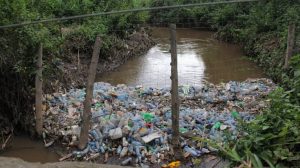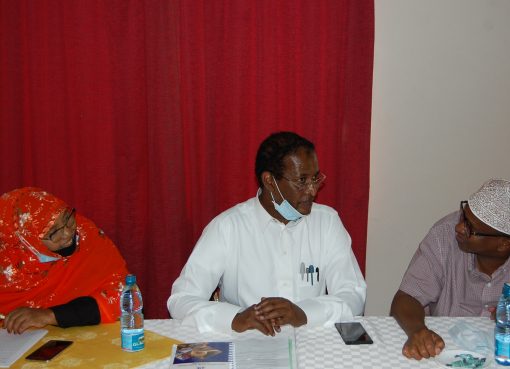
Environmentalists have expressed concern over increased discharge of single use plastic bottles, cutlery and utensils into waterways in Nakuru County.
Official records have listed water bodies whose ecosystem is increasingly being threatened by the menace as Lakes Nakuru, Naivasha, Elementaita, Rivers Njoro, Ndarugo, Ngosur and Molo.
The Lake Nakuru National Park Senior Warden, Catherine Wambani says at least 30 to 40 tonnes of single use plastic containers find their way into Lake Nakuru National Park every rainy season, posing danger to the wildlife and are a threat to one of Kenya’s most visited parks.
Christine Wangari, the Executive Director to Multi-Touch International, an environmental Conservation nongovernmental organisation observed that the single use plastic waste is generated from the County’s urban centres and residential estates before being swept into lakes through storm water and rivers.
“About 80 percent of plastic rubbish flows into these lakes from rivers and storm water. Focusing on the clean-up of rivers and coming up with legislations that will outlaw use and manufacture of the single use items is the best way to minimise flow of these non-degradable pollutants into our water bodies. We need laws that compel manufacturers to take responsibility for the waste they produce,” says Ms Wangari.
The environmentalist indicated that she is engaging a section of members of parliament to draft legislation to ban the manufacture of single use bottles, plastic straws, cutlery, and cups that are chocking waterways in the country.
Ms. Wangari says the ultimate source of the problem – Kenyan’s ‘newfound’ dependence on throw away plastic products – should be tackled through total ban on single use plastic containers.
“Single use plastic bottles are now a major cause of pollution and reduce the habitats. We have come across animals entangled with these bottles. If ingested by the wildlife, they end up dying and pull back our efforts on conservation. We must ban plastic bottles and give another industry an opportunity to fill the gap created,” she affirms.
Various Laboratory analysis sponsored by government agencies, educational institutions and researches have confirmed that a significant proportion of the plastic containers retrieved from waterways contained chemical traces which in turn endanger marine life and wild animals.
While launching the infrastructure spatial plan for Lake Nakuru National Park the Kenya Wildlife Service (KWS) lamented that it was now diverting resources that are meant for other purposes into retrieving plastic bottles from Lake Nakuru and River Ndarugo.
KWS has challenged the Nakuru County government to take drastic measures to curb the plastic bottle menace are non-biodegradable and were harming animal and aquatic life.
“If this continues unchecked, the lake will eventually be too toxic for the current aquatic life as well as herbivores that often come into contact with non-biodegradable material leading to their deaths.
“This new pollution challenge from the town is getting out of hand. When it rains, flood water carries tonnes of plastic waste into the lake and thereby killing it slowly,” says the Senior Park Warden, adding that every week over 500 kilogrammes of plastic bottles are collected from the park and this increases during heavy rains.
Ms. Wambani reveals last month alone, 28 tons of single use plastic bottles were retrieved from a screen constructed at a point where the River flows into the Lake.
The county government states, Ms Wambani needs to allocate enough funds to solid waste management.
“There is a need for adequate funding in waste management. We want to see the current situation of the dumping sites spilling over rectified. The Kenya Wildlife Service (KWS) has done its part by launching an infrastructure spatial plan for Lake Nakuru National Park to help mitigate pollution of the wildlife habitat and conserve affected species of wildlife whose population is fast dwindling,” says the Senior Park Warden.
Governor Lee Kinyanjui says the County Government and the German Development Bank are fine-tuning a Sh.
3billion solid waste management programme that will help to reduce deposits of waste to waterways.
Kinyanjui notes that the upgrade of the current 40 year old sewerage system in Nakuru town will enhance separation of storm water, a main culprit in sweeping plastic bottles into water bodies, from waste water from residential areas for appropriate filtering and safe disposal.
The County boss says mutual waste recycling partnerships with wildlife stakeholders within Nakuru town anchored on Reducing use, Recycling and Reusing (3Rs) model is significant in conserving the wildlife.
“Uncoordinated plastic bottle waste management system has exposed wildlife to toxic metals and harmful bacteria which has decimated populations of various species of animals at the wildlife facility,” he says.
“The county government of Nakuru is seriously undertaking its mandate of ensuring that litter is collected and disposed of well, so that it’s not swept into water bodies whenever it rains,” says the governor.
Kinyanjui affirms that in addressing the plastic bottles menace, Kenya Wildlife Service will continue to foster partnerships with members various communities, business organizations as well as environmental conservation institutions to protect the ecosystem as well as address other environmental matters in the region.
“Safeguarding our environment ranks on the top of the list of our administration. We understand that when our environment is safe our people prosper, but when it is polluted and damaged their livelihoods standards are injured,” states the governor.
Two years ago, Kenya banned the use, manufacture and sale of environmentally harmful plastics, polythene bags and packaging materials. The ban was challenged but the courts upheld it.
In June this year, while addressing the “Women Deliver 2019 Conference”, in Vancouver Canada, President Uhuru Kenyatta announced a ban on single-use plastic bottles in beaches, national parks, forests and conservation areas.
In effect, this means Kenyans going to the beach or national parks are banned from carrying water bottles, plastic plates, plastic cups as well as plastic spoons and forks.
By Jane Ngugi/Wayne Mark



